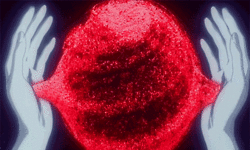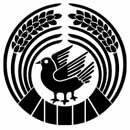For the Age of Miroku

Welcome
If I am honest, over the last year and a half of my life, I almost lost the plot, at least a few times.
It became very obvious to me that cancel culture, Qanon, the alt-right and other viral online phenomena were ways in which rapidly expanding virtual world of the URL was highly pressurizing the limits of the earthly material world of the IRL we live in.
There were times, when I somberly looked at the immense amount of energy that was coalescing into a very sharp inflection point, not so far off in the distant future, I felt the end of the world, at least as we know it - of being turned totally inside out, thrown into what is completely unknown territory for human civilization.
We are being swallowed whole by our fate, as we stubbornly cling to the virtue of ideology, rather than see that we are made of flesh and it is of no advantage to us to fight each other on the behalf of abstract ideas trying to gain their share in the marketplace of our collective psyche.
More than once, I wondered about giving it all up and living in a monastery in a mountain for the rest of my life.
But amidst all of it, I kept coming back to my hearts sorrowful longing, for the Ubusuna.
Ubusuna (産土), in Japanese, spelled "birth-soil", refers to the Kami, or spirits, of our birth lands. Assigned to us at birth, they are understood to be one of our greatest protectorates throughout our lives. Particularly, the Ubusuna are responsible for arranging our relationships, including intimate partnerships.
This system, where Kami of the Land are understood to intervene in relationships on behalf of us, recognizes that our human connections are innately enfolded within a larger ecosystem. Gratitude for the relationships brought together by the Land is reciprocated by protecting and benefiting the Land itself. The Ubusuna system is largely responsible for the centuries long maintenance of small ecologically sustainable agrarian communities in Japan and East Asia at large.
Studying and being withese these beloved and also sometimes very challenging Kami, as well as doing a deep dive into the larger cosmology of Japanese spirituality saved me quite often over the last 20 months. I put my head down in this work because I deeply felt that learning the deeper workings of the Ubusuna Kami will help me, and maybe others, understand how human relationships act as remediation tools that draw up and alchemize the toxicities that have come to be embedded in the Land itself.
A particularly salient point was contemplating what does it mean for our relationships to be organized by spirits of ecosystems when our lives have reached such a point that the ecosystems that we are embedded are not only based in the material plane but also in the virtual. Whose interests are we actually serving unaware if more and more our relations are being organized by online algorithms?
This exploration led me to the core issue that this course would like to address: the tension between Earth and the new Heaven of the Metaverse that is expressed in the friction of modern human relationships.
Through this immersive research process, I also came to learn and accept that, as a member of the Hozumi clan, I come from the world's longest continuous and documented line of shamans, with our origins stretching back thousands of years ago, before the birth of the current Japanese imperial state, even back to the distant lands of ancient mesopotamia.
I did not know that when I first innovated 'cultural somatics', the framework for somatic psychotherapy that sees cultures as bodies with a collective nervous system, that I was in fact retracing the steps of many of my ancestors who served both the Japanese imperial court and local tribal settlements as spirit workers who performed rituals as the core practice of governance.
In fact, the Japanese word for ceremony or festival, Matsuri (祭) is also the same word for governance, Matsurigoto (政).
This is also the place I have come to the decision of offering this course, the first I've offered in almost two years, Ubusuna, as my first step into taking on the role of hereditary steward of the Hozumi family line, as an emissary in diaspora.
Particularly, what I would like to share with a group of folks who are ready and interested is our 'family secrets': the frameworks and practices that have formed the core of Japanese spirituality, often known as Shinto but is actually of a much wider breadth, that has allowed ancient traditions of ecological spirituality to be protected, preserved, and transmitted over thousands of years. As an uninitiated and errant son that is far from home, it is a deeply humbling opportunity to be able to offer this knowledge of my ancestors with others as genuine tools that may help us navigate the thorniest times that await us and our descendants - especially the descendants.
That said, it's important I point out that Ubusuna is not a survey course on Shintoism or any related tradition. There are many studied researchers and practitioners that can offer programs that covers such terrain.
Rather, what I offer in this course is an exploration of the often hidden esoteric nature of Japanese spirituality, with secretive roots that go back not only to early indigenous religions of the Island, but also to the mystical traditions of the ancient Near East. If anything, I have learned to see Japanese spirituality as an expression of an ancient ecological syncretized spirituality that was able to take roots in the fertile soil of the Islands and has been protected and preserved in an unusually intact form. To this day, there are more shrine sites than there are convenient stores in Japan ... that's a lot of shrines!
My thesis is that understanding the aesthetics, sensibilities, and concepts behind Japanese spirituality can also help reveal the deeply ecological nature of humanity's earliest mystery traditions, which may in turn greatly helps us gather spiritual technologies that can helps us, as modern Westerners, create, protect, and preserve a culture that is wholly rooted in nondualism and an ecological religiosity.
This is very important because we currently live in a time where we are not just facing a spiritual crises in the form of our Earth's ecosystemic collapse under the pressure of our progress, but also our very understanding what is a human, what is a soul, is becoming rattled by the birth of intelligent online technologies. While the planet burns up, blockchain, social media, VR, AI, and the Metaverse are reflecting back to us how exactly our psyches are constructed, all the while we stare into the void of our mobile devices.
Following, an ecological spirituality that adequately meets the crises of 21st century must also necessarily take into account, not just the living and intelligent nature of the 'wild' non-human world, but also the reality that this also includes the Metaverse and the digital entities that inhabit them.
To this end, I have created a curriculum for this course that includes a combination of anthropological research, experiential information gained through channeling, and distillation of knowledge into Kata, that is embodied ritual forms, by yours truly.
The goal here isn't to indoctrinate anyone into a spiritual system I've created although everyone is very welcome to take whatever pieces they receive from this course into their practices. I am much more interested in how I can share my explorations in a way which we can further learn together, how to receive the gifts of our ancestors, especially by digging at the roots of human spirituality and understanding its deep science, so that we can create new religions unto ourselves that are not just unique to us but can communicate with one another through our understanding of a common human spiritual fabric.
If this sounds resonant and exciting to you, I invite you to keep reading below to learn more.
Thank you and humbly yours,Shindo Hozumi (nee Tada Hozumi)Hereditary steward of the Hozumi clan
Curriculum
Oct 20thSumeragi: The Near East origins of Japanese spirituality
Understanding the waves of migration from the Near East
The Mononobe and Hata family lines
Comparing The Mikoshi and the Ark of the Covenant
Comparing various rituals and forms of worship
Nov 1stPractice class: Hara cultivation
Gut-brain and oppression
Oct 27thOn Musubi: The Hieros Gamos of Japanese ecological spirituality
Opening Prayer: Ooharae-no-Kotoba (Great purification prayer)
Understanding the cosmogony of Kata (casual and seen) and Kamu (acasual and unseen)
The tantric union of Musubi and the erotic syncretization of tribal and imperial cultures
Understanding the Earthly and Heavenly Kami
URL and IRL as the new Heavenly and Earthly realms
Nov 1stPractice class: Seman no Kata
Introduction to Onmyodo (Yin-Yang Way)
The Five elements and the world of Kata and Kamu
Study of the protection pentagram sigil of Abe-no-Seimei
Nov 3rdGnostic Shinto: The cosmology of Serpents, Beasts and Dragons
Opening Prayer: Ryujin Norito (prayer to the Dragon Kami)
The tradition of Dragon-Serpent cultures and their nondual world views
Nov 7thPractice class: Doman no Kata (Kuji)
Introduction to Shugendo
Tengu, Ninja, and Merkaba / Kabbalah mysticism
Study of the protection pentagram sigil of Doman Ashiya
Nov 10thHara and Kabbalah: The Seed and The Tree
Opening Prayer: Tokusa-no-Kandakara-no-Norito (Prayer of the Ten Divine Treasures of the Dragon Lord)
Working with the Sephiroth and Qliphoth, a Japanese nondual approach
Nov 13thPractice class: Onyowago no Kata
A deeper dive into the Kabbalah and Merkaba mysticism roots of Shinto
Study of Yin-Yang harmonization sigil of hexagram and cross
Nov 17thUbusuna returns: Working with Spirit as Algorithm and Algorithm as Spirit
Opening Prayer: Katakamuna 5, 6, 7
Understanding algorithms as ubusuna
The energetics of social media
Cost
Early bird regular $250Early bird bursary $200Late bird regular $300Late bird bursary $350
